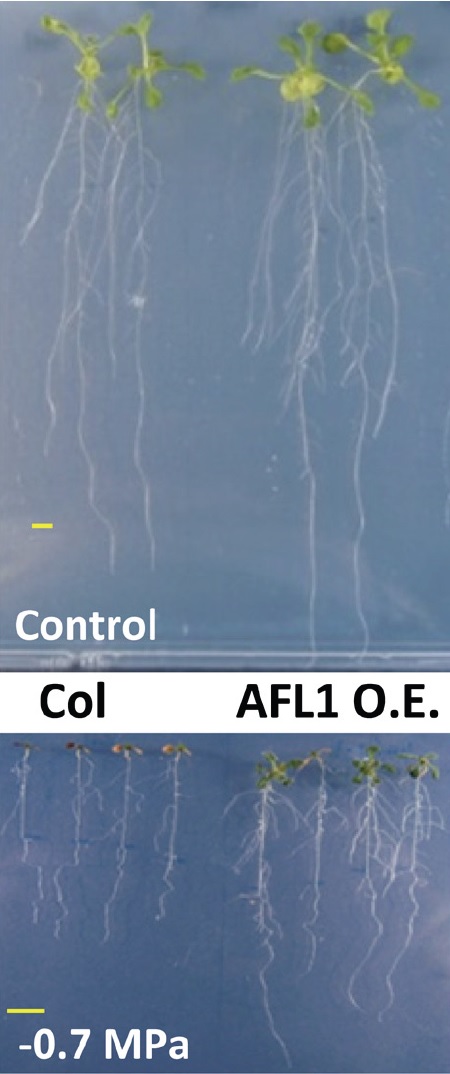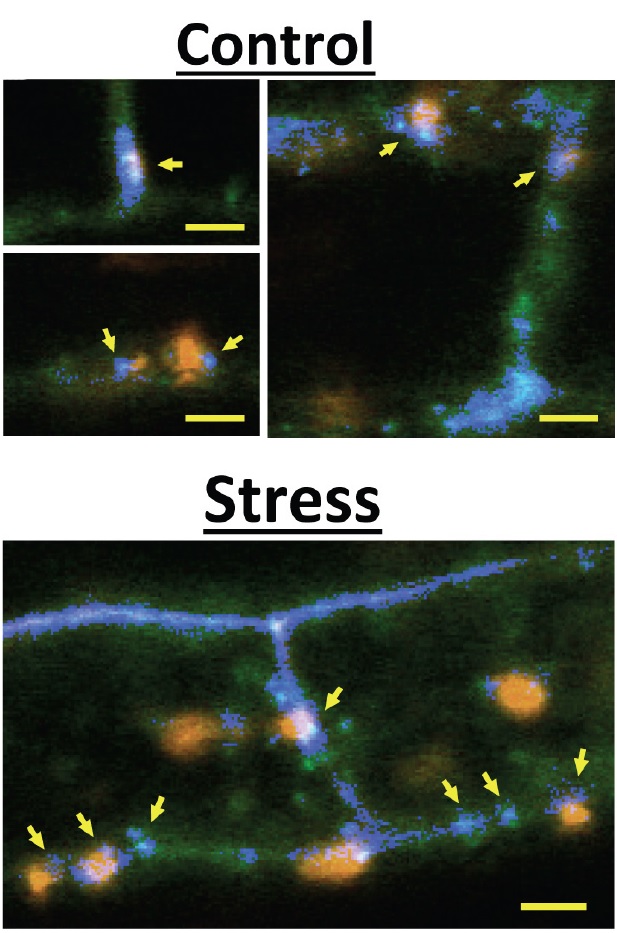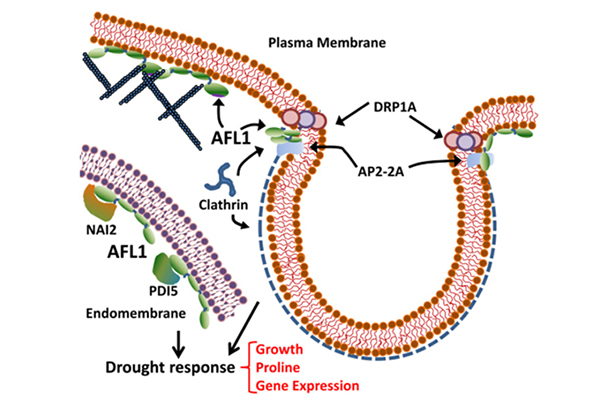At14a-Like1 Participates in Membrane Associated Mechanisms Promoting Growth During Drought in Arabidopsis thaliana
Abstract
Drought is a major cause of lost agricultural productivity worldwide; however, the mechanisms of stress sensing and cellular regulation that determine plant growth and productivity during drought are little understood. In this study we identified a new type of plant stress signaling protein, At14a-Like1 (AFL1) involved in previously uncharacterized membrane-associated drought sensing or signaling mechanisms. Increased expression of AFL1 led to increased growth during drought stress without negative effects on unstressed plants. Transcriptome analysis indicated that AFL1 may promote growth in part by suppression of negative regulatory genes. AFL1 protein interactions, plasma membrane association and co-localization with clathrin light chain, as well as AFL1 structure all indicated a role in vesicle formation or trafficking.
Drought and soil drying restrict the amount of water available to plants and lead to many changes in gene expression, metabolism and growth. In crop plants limited water availability during drought leads to severe losses in productivity. Drought stress is one of the most serious limitations on agriculture production globally. Limited knowledge of how plants regulate their growth and metabolism in response to drought and reduced soil water potential has impeded efforts to improve plant stress tolerance.
Sensing and early signaling of drought stress may involve membrane-associated proteins; however, these proteins and signaling mechanisms are yet to be identified. We investigated the stress function of At14a-Like1 (AFL1) because of its stress-induced expression and possible role as a membrane signaling protein. Overexpression of AFL1 in the model plant Arabidopsis thaliana led to increased growth and increased accumulation of the stress-protective metabolite proline during drought stress without negative effect on unstressed plants (Figure 1). Conversely, suppression of AFL1 made the plants more sensitive to growth inhibition by water limitation and also impaired proline accumulation. Gene expression analysis showed that increased AFL1 expression led to decreased expression of many other genes during drought. Thus, the effect of AFL1 on drought response may occur in part through suppression of genes which downregulate growth.

Figure 1.
AFL1 promotes growth under stress without detrimental effect on unstressed plants. Representative Arabidopsis thaliana seedlings of Columbia-0 (Col) wild type and AFL1 overexpression (AFL1 O.E.) ten days after transfer to either unstressed control or moderate severity low water potential (drought) stress (-0.7 MPa). Overexpression of AFL1 increased growth in both conditions but much more dramatically in the stress treatment. Scale bars = 1 cm.
AFL1 is an uncharacterized protein and at the outset of our study nothing was known of its cellular function. We identified AFL1 interacting proteins as one way to better understand AFL1 molecular function. AFL1 interaction with Adaptor protein 2-2A (AP2-2A), a protein involved in vesicle formation, indicated a role for AFL1 in endocytosis of plasma membrane vesicles. Consistent with this function, we observed co-localization of AFL1 with clathrin light chain (CLC) in small foci along the plasma membrane indicative of vesicle formation (Figure 2). In addition to its localization and function at the plasma membrane, AFL1 also interacted with endoplasmic reticulum signaling proteins PDI5 and NAI2 and analysis of pdi5 and nai2 mutants indicated that they act as negative regulators of growth during drought. Thus AFL1 effect on plant growth and stress resistance may involve both plasma membrane and ER functions of AFL1 (Figure 3). Understanding these AFL1 functions is a topic of continuing research in our laboratory.

Figure 2.
AFL1 colocalization with clathrin light chain (CLC) indicates a role in endocytosis of plasma membrane vesicles. Confocal microscope images where green indicates fluorescently labeled AFL1, orange indicates CLC and blue indicates regions where both proteins are found (colocalization). AFL1-CLC colocalization is seen at the margins of vesicle like particles or at sites indicative of the early stages of vesicle formation (marked by arrows) along the plasma membrane. Scale bars = 5 μm.

Figure 3.
Summary of AFL1 interactions and localization.
AFL1 was found to be a peripheral membrane protein associated with both plasma membrane and endomembrane. At the plasma membrane, AFL1 interaction with AP2-2a and colocalization with CLC indicate a role in vesicle formation. In endomembranes, AFL1 interacted with PDI5 and NAI2 which are negative effectors of drought response. Together, these roles of AFL1 have dramatic impact on plant growth during drought stress.
This mechanistic analysis of AFL1 demonstrated that it affects drought resistance via mechanisms distinct from known plant stress signaling pathways. It is also consistent with the hypothesis that plants down-regulate their growth more than needed during mild stress as a conservative strategy to prepare for survival of more severe soil drying. Disabling such negative regulator y mechanisms is a promising way to improve plant growth during drought and is potentially more publically acceptable than biotechnology strategies that involve expression of foreign genes in plants. AFLl overexpression does not inhibit growth in the absence of stress and thus circumvents a common problem seen plant stress research. Further experiments to test whether AFL1 can increase growth when expressed in other plant species are ongoing. This is a first step to assess the potential translational use of AFL1 to improve drought resistance of economically important plant species.
Proceedings of the National Academy of Sciences USA 112 (2015): 10545-10550.
DOI: 10.1073/pnas.1510140112